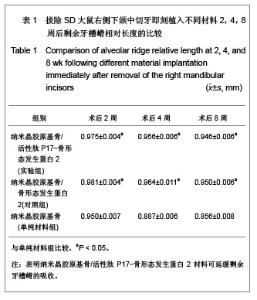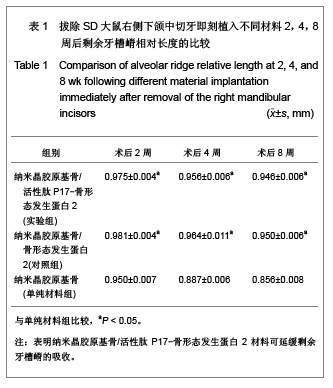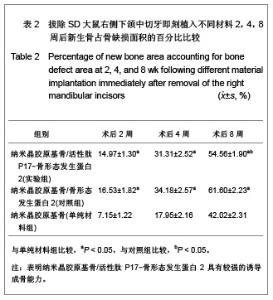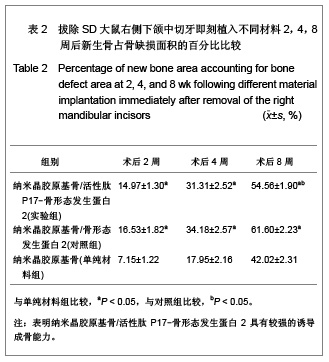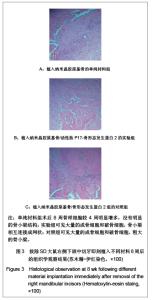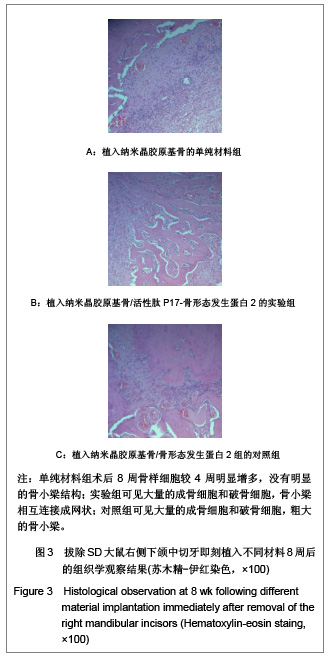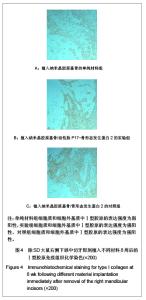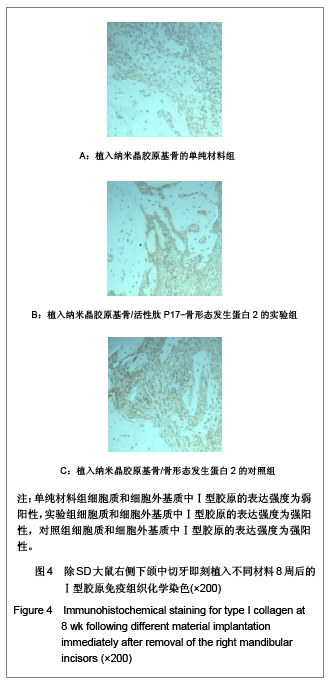| [1] Liao SS,Cui FZ,Zhang W.Zhongguo Yixue Kexueyuan Xuebao. 2003;25(1):36-38. 廖素三,崔福斋,张伟.组织工程中胶原基纳米骨复合材料的研制[J].中国医学科学院学报,2003,25(1):36-38.[2] Feng QL,Cui FZ,Zhang W.Zhongguo Yixue Kexueyuan Xuebao. 2002;24(2):124-128. 冯庆玲,崔福斋,张伟.纳米羟基磷灰石/胶原骨修复材料[J].中国医学科学院学报,2002,24(2):124-128.[3] Kim CS,Kim JI,Kim J,et al.Ectopic bone formation associated with recombinant human bone morphogenetic proteins-2 using absorbable collagen sponge and beta tricalcium phosphate as carriers. Biomaterials.2005;26(15): 2501-2507.[4] Yoneda M,Terai H,Imai Y,et al. Repair of an intercalated long bone defect with a synthetic biodegradable bone-inducing implant. Biomaterials.2005;26(25): 5145-5152.[5] Einhorn TA,Majeska RJ,Mohaideen A,et al.A single percutaneous injection of recombinant human bone morphogenetic protein-2 accelerates fracture repair. J Bone Joint Surg Am.2003;85A(8): 1425-1435.[6] Faria ML,Lu Y,Heaney K,et al.Recombinant human bone morphogenetic protein-2 in absorbable collagen sponge enhances bone healing of tibial osteotomies in dogs. Vet Surg.2007;36(2): 122-131.[7] Schmiedt CW,Lu Y,Heaney K,et al.Comparison of two doses of recombinant human bone morphogenetic protein in absorbable collagen sponges for bone healing in dogs. Am J Vet Res.2007;68(8): 834-840.[8] Carstens MH,Chin M,Li XJ. In situ osteogenesis: regeneration of 10-cm mandibular defect in porcine model using recombinant human bone morphogenetic protein-2 (rhBMP-2) and helistat absorbable collagen sponge. J Craniofac Surg. 2005;16(6): 1033-1042.[9] Lee JY,Zeiller S,Voltaggio L,et al. Histological analysis of a displaced femoral ring allograft spacer filled with a recombinant human bone morphogenetic protein-2-soaked collagen sponge - a case report. J Bone Joint Surg Am.2005; 87A(10): 2318-2322.[10] Horvath KA,Doukas J,Lu CY,et al. Myocardial functional recovery after fibroblast growth factor 2 gene therapy as assessed by echocardiography and magnetic resonance imaging.Ann Thorac Surg.2002;74(2):481-486.[11] Zhang LJ,Wang Y,Wu YL,et al.Zhongguo Guzhi Shusong Zazhi. 2004;10(2):155-157. 张丽军,王影,吴燕丽,等.胶原基纳米骨修复兔下颌骨缺损的实验研究[J].中国骨质疏松杂志,2004,10(2):155-157.[12] Shen TC,Huang YH,Xu XF,et al.Yixue Yanjiu Zazhi. 2006; 35(4):70-73. 沈铁城,黄永辉,徐晓峰,等.纳米晶胶原基骨材料在临床上的应用[J].医学研究杂志,2006,35(4):70-73.[13] Liao FQ,Zhang J,Wu YL,et al. Zhongguo Guzhi Shusong Zazhi. 2004;10(3):316-329. 廖福琴,张洁,吴燕丽,等.胶原基纳米骨修复拔牙创及颌骨囊肿术后骨腔的疗效观察[J].中国骨质疏松杂志,2004,10(3):316-329.[14] Ning BQ,Cui FZ,Hu K,et al. Zhongguo Zuzhi Gongcheng Yanjiu yu Linchuang Kangfu. 2009;13(21):4049-4054. 宁博强,崔福斋,胡坤,等.活性胶原基纳米骨修复下颌骨缺损的组织学检测[J].中国组织工程研究与临床康复,2009,13(21): 4049-4054.[15] Du C,Cui FZ,Zhu XD,et al.Three-dimensional nano-HAP/collagen matrix loading with Osteogenic cells in organ culture.J Biomed Mater Res.1999;44(4):407-415.[16] Cui FZ,Wen HB,Su XW,et al.Microstructures of external periosteal callus of repaired femoral fracture in children. J Struct Biol.1996;117(3):204-208. [17] Wen HB,Cui FZ,Feng QL,et al. Microstructural investigation of the early external callus after diaphyseal fractures of human long bone. J Struct Biol.1995;114(2):115-122.[18] Zhou DS,Zhao KB. Repair of Segmental Defects with Nano-hydroxyapatite/Collagen/PLA Composite Combined with Mesenchymal Stem Cells. J Bioact Compat Polym.2006; 21: 373-384.[19] Dong JL,Li LX, Mu WD. Bone regeneration with BMP-2 gene-modified mesenchymal stem cells seeded on nano-hydroxyapatite/collagen/poly(L-lactic acid) scaffolds. J Bioact Compat Polym.2010;25: 547-566.[20] Wu Z,Sun HC,Liu ST,et al.Zhonghua Kouqiang Yixue Zazhi. 2006;41(12):747-750. 吴哲,孙宏晨,刘树泰,等.聚乳酸-羟基乙酸-辛伐他汀对拔牙术后剩余牙槽嵴吸收影响的实验研究[J].中华口腔医学杂志,2006, 41(12):747-750.[21] Saito N,Takaoka K. New synthetic biodegradable polymers as bmp carriers for bone tissue engineering. Biomaterials. 2003; 24(13): 2287-2293.[22] Griesenbach U,Geddes DM,Alton EW.Advances in cystic fibrosis gene therapy. Curr Opin Pulm Med.2004;10(6): 542-546.[23] Wang L,Huang YL,Pan KF,et al.Zhongguo Kouqiang Zhongzhixue Zazhi. 2011;14(2):173-181. 王磊,黄远亮,潘可风,等.复合BMP-2/bFGF的多孔磷酸钙修复种植体周围骨缺损的实验研究[J].中国口腔种植学杂志,2011, 14(2): 173-181.[24] Duan Z,Zheng Q,Guo X,et al.Experimental Research on Ectopic Osteogenesis of BMP-2-derived Peptide P24 Combined with PLGA Copolymers.J Huazhong Univ Sci Technolog Med Sci.2007;27(2):179-182.[25] Ning BQ,Cui FZ,Hu K,et al. Zhongguo Zuzhi Gongcheng Yanjiu yu Linchuang Kangfu. 2009;13(21):4049-4054. 宁博强,崔福斋,胡坤,等.活性胶原基纳米骨修复下颌骨缺损的组织学检测[J].中国组织工程研究与临床康复,2009,13(21): 4049-4054.[26] Duan ZX,Zheng QX,Guo XD,et al.Guoji Shengwu Yixue Gongcheng zazhi. 2007;30(3):129-132. 段智霞,郑启新,郭晓东,等. BMP2活性多肽PLGA复合物植入异位成骨的实验研究[J].国际生物医学工程杂志,2007,30(3): 129-132.[27] Liu B,Wang ZY,Chen P,et al.Kouqiang Yixue Yanjiu. 2006; 22(2):123-125. 刘冰,王忠义,陈鹏,等.活性胶原基纳米骨修复即刻种植体周围骨缺损的研究[J].口腔医学研究,2006,22(2):123-125.[28] Ueda H,Hong L,Yamamoto M,et al.Use of collagen sponge incorporating transforming growth factor-beta 1 to promote bone repair in skull defects in rabbits. Biomaterials.2002;23(4): 1003-1010.[29] Kirsch T,Sebald W,Dreyer MK. Crystal structure of the bmp-2-bria ectodomain complex. Nature Structural Biol.2000; 7(6): 492-496. |
